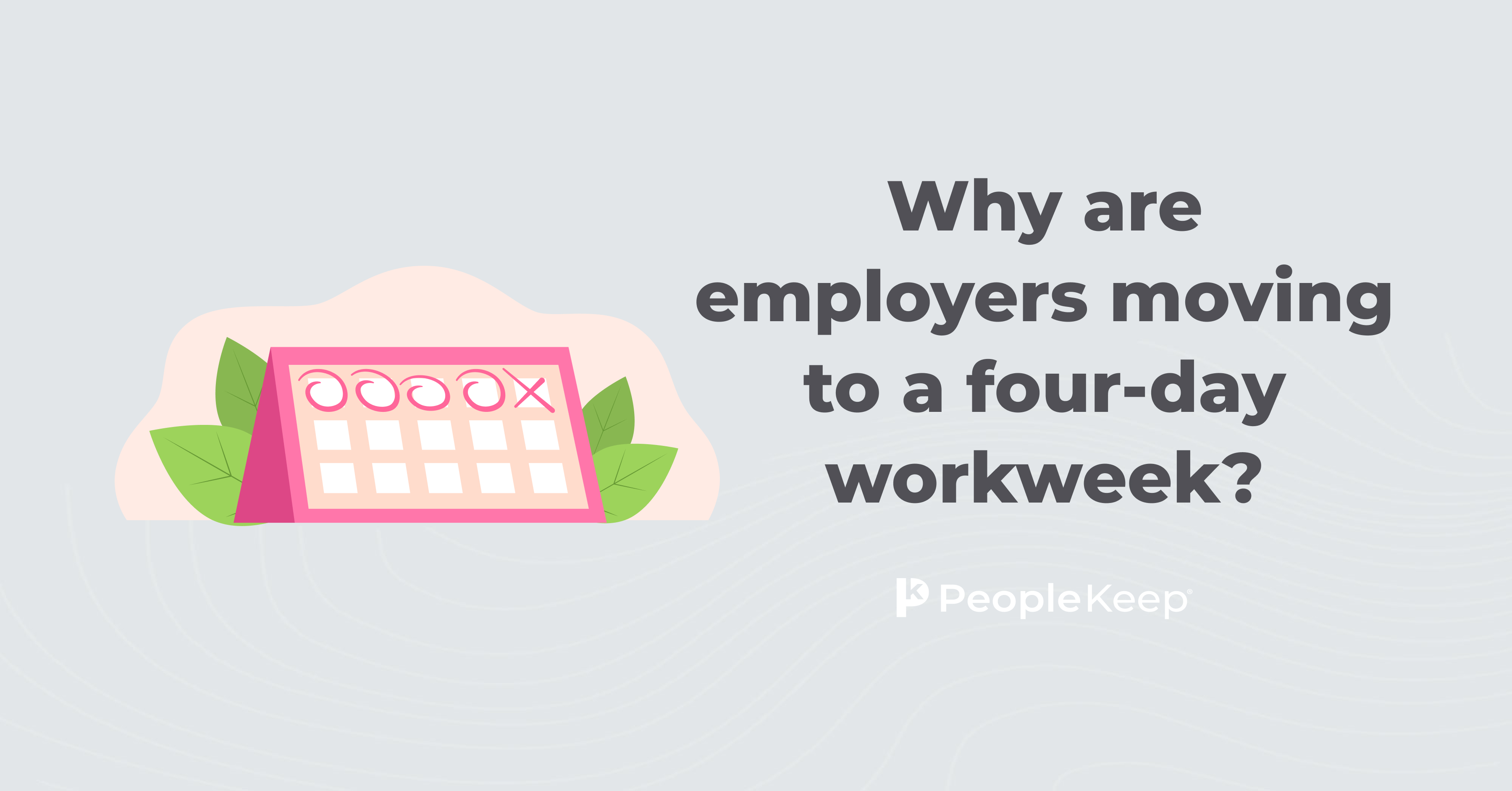Employee burnout: what it is and how to prevent it
By Elizabeth Walker on May 24, 2024 at 1:20 PM
Employee burnout has become an epidemic in today’s modern workplace. So much so that the World Health Organization (WHO) officially recognizes it as an “occupational phenomenon.”1
While many used to consider mounting workplace stress an individual employee problem, these days, it’s become an employer’s responsibility to prevent burnout before it hurts productivity and business performance—not to mention your employees’ physical and mental health.
Luckily, you can prevent burnout from affecting your workforce in several ways. This article will explore the causes and signs of employee burnout and the steps you can take to create a positive work environment where employees feel safe from toxic stress levels.
Takeaways from this blog post:
- Employee burnout is a psychological state caused by chronic work-related stress. It can lead to mental and physical health issues.
- Common causes of employee burnout include being overworked or underworked, unbalanced compensation, a poor work environment, and a lack of support from management.
- Employers can help prevent burnout by reducing workloads, showing appreciation, improving communication, and offering personalized benefits.
What is employee burnout?
Employee burnout is a psychological state of mental and physical fatigue caused by chronic workplace stress, extreme frustration, excessive work hours, or other issues. For example, a poor work environment, lack of support, or a heavy workload can contribute to burnout.
Whatever the cause, burnout can affect an employee’s physical and mental health. For employers, burnout can lead to higher turnover rates, lower employee engagement, and reduced morale due to a negative workplace culture.
The tricky thing about burnout is you may not even know it’s happening at your organization. A recent report found that 65% of American workers felt burned out in 2023, and 72% of employees believe it impacted their productivity2.
In the past, burnout was just considered a minor side effect of trying to advance in one's career. But, most experts now consider employee burnout to be an issue that employers need to be wary of. So, it’s up to you to address the issue to retain and keep your employees happy.
What are the common causes of employee burnout?
1. Your employees are overworked
An overwhelming workload can put uncomfortable pressure on your employees that they may be unable to manage. When employees are overworked and tasks begin piling up, it can be frustrating, and the stress can cause them to shut down.
This stress and frustration can lead to unproductivity or motivate them to look for shortcuts to finish tasks, leading to errors. Additionally, their frustration could push them to look for a new job entirely as a means of escape.
If employees push themselves past their limit, their mental health can suffer, and burnout will kick in sooner than if they had a more manageable workload.
2. Your employees are underworked
Being overworked is undoubtedly a cause of burnout, but not having enough work can also be a factor. Burnout can happen when employees don’t feel connected to their work. It can also set in if they’re not provided enough engaging and complex tasks to work on or are frequently required to do repetitive tasks.
When employees aren’t passionate about what they do or have too little to do, productivity, satisfaction, and morale can decrease. And ultimately, this can increase the rate of burnout in your organization.
3. Unbalanced compensation
Another reason for burnout is when employees don’t feel their compensation is in line with their work—whether that’s the type of work they’re doing or the amount. Similarly, modern workplace burnout can also result if employees feel their compensation is affected by unfair treatment, such as bias, favoritism, mistreatment, and unjust policies.
Compensation and workplace fairness are important issues to review consistently in the workplace. Regardless of burnout, these issues can lead to decreased job satisfaction, negative workplace culture, absenteeism, or employee turnover.
4. Poor work environment
A poor work environment will likely lead to poor job performance and frustration. If employees aren’t motivated to come to the office or log on to their computer if they’re remote, feelings of burnout aren't far away.
A negative work environment can be due to unclear job responsibilities, poor work-life balance, neglectful management, or not being appreciated for good work.
5. Lack of support from management
Lastly, employees need to know that their managers are there to support them. Effective managers who allow their staff to speak openly without fear of being judged go a long way toward building an employee’s confidence in your overall organization.
In contrast, engagement and satisfaction tend to drop when employees don't feel cared for or valued by their manager. If they don’t feel comfortable opening up, employee productivity and morale can lessen, creating a risk of burnout and spiking your turnover rate.
What are the signs of employee burnout?
1. Sickness and absenteeism
Employee burnout isn't a medical diagnosis. However, if burnout is prevalent in your organization, you’ll likely see a rise in employee absences due to illness, physical exhaustion, or stress.
Noticing if someone is experiencing burnout can be challenging if your workforce is entirely remote. But if you track PTO or sick days, you may be able to see if employee stress or anxiety is rising. If an employee suddenly becomes absent more often or is late to work, this could be a sign of burnout.
Depending on the levels of burnout, increased stress and anxiety can lead to depression, which in turn can have devastating physical effects on the body, like stomach aches, headaches, insomnia, and lack of appetite3.
2. Increased mistakes
If your employees are burned out, their daily tasks may be prone to more mistakes as they’re less careful about their actions due to emotional exhaustion. Extreme exhaustion makes it hard to concentrate and, therefore, difficult to be productive, resulting in mistakes. Employees may also look to shortcuts to catch up if they’re overwhelmed.
When an employee makes a mistake, they may feel guilty and respond to that guilt by getting angry. Anger can bring down team morale and worsen focus on projects, letting more mistakes seep through and reducing overall business performance.
3. Lack of motivation
Burned-out employees are less motivated, less innovative, and less efficient. They may be late to work or fail to complete assignments promptly. They may also be prone to skipping meetings, not participating in meetings, or avoiding speaking up.
It can be challenging to determine if someone has lost their motivation if you’re in a remote setting. With nothing but chats and video calls, you may have little to go on. But if you sense via speech or body language that an employee seems sluggish, you may be dealing with burnout.
4. Poor decision making
Burnt-out employees tend to make poor decisions more frequently. Because they’re overwhelmed or lack confidence, they may not take adequate time to thoroughly consider their actions or simply procrastinate.
Understandably, you may not want to keep an employee who isn’t making the best decisions. That’s why this symptom is likely to lead to high turnover rates and higher overall recruiting costs to replace them.
5. Reduced productivity and engagement
Employee burnout ultimately leads to poor performance because of lower productivity. Reduced productivity can result from employees working long hours, job dissatisfaction, or having too much responsibility.
However, engagement and productivity usually go hand in hand. Unproductive employees are more likely to leave their jobs because they’re disengaged. And lack of engagement can hurt your bottom line. For example, a disengaged customer support employee may mishandle a customer’s needs, which can negatively affect your company.
How you can prevent employee burnout
Employee burnout isn’t inevitable. You can prevent it if you look for signs of burnout ahead of time. To combat burnout in your organization, follow the seven steps below.
1. Reduce the workload
While workplace stressors are a natural part of life, they’re also one of the main reasons for burnout. Reducing workload and encouraging less task-switching can play a critical role in having more productive, focused, and happier employees.
In fact, promoting less task-switching can make your employees more efficient. Studies show that switching between tasks actually slows us down, makes us prone to mistakes, reduces productivity, and increases stress4.
If you’re looking for ways to reduce workload or keep your employees focused, try thinking outside the box. You can spread a project between an entire team instead of assigning one person to work on it. Or you can encourage employees to mute their communication channels when they need to focus so the notification sounds don’t distract them.
2. Promote autonomy
When employees have autonomy over their work, they become accountable for their success. Autonomy isn’t just empowering for your employees. It can also build confidence and self-esteem and increase engagement—all things that can help reduce burnout.
Every organization will have a different vision of autonomy, but there are some steps you can take to get started.
You can increase autonomy in the workplace by doing the following:
- Support your employees’ career growth and professional development.
- Build a company culture based on trust, inclusion, and understanding.
- Encourage employees to take ownership of their actions.
- Allow employees to set goals and benchmarks for projects and tasks to promote accountability.
- Reward good work so your employees understand that their efforts contributed to the organization’s success.
- Allow for mistakes and respond to them as a learning opportunity—not a criticism.
3. Set a clear path to career growth
One of the most effective ways to increase employee engagement and decrease burnout is by offering development opportunities within your organization.
According to the APA’s 2023 workforce survey, 91% of employees say it’s somewhat or very important to have learning opportunities at work. However, only 47% say their employer provides these opportunities5.
By providing a clear career path, you can ensure that your employees stay energized and productive. They envision how they can progress through different layers of your organization and ultimately land a leadership role. This is especially enticing to employees who may already feel burned out and “stuck in a rut” in their current position.
“By supporting employees’ career aspirations and providing opportunities for skill enhancement, we keep them engaged and motivated, says Connor Ondriska, CEO of Spansh VIP. “This not only helps prevent burnout but also fosters a sense of purpose and progression within the organization.”
Your career development plan can include training programs, online courses, or workshops that teach employees about specific industry topics or expose them to careers and responsibilities in different departments.
You could also set up a mentorship program with senior team members to guide employees through challenging projects, offer advice and support, and help them manage stressful situations.
4. Improve work-life balance
Work-life balance has become an increasingly important topic over the past few years, and for good reason. Promoting a healthy work-life balance is essential to creating a positive work environment and preventing burnout in your company.
You can promote a strong work-life balance at your organization by:
- Having a strict no-emailing policy on the weekend or after work hours. This is known as the right to disconnect.
- Choosing predetermined log-off times so employees don’t overwork.
- Setting aside a certain amount of paid time off (PTO) for self-care days so employees can recharge.
- Implementing a policy that chat responses can come within 24 hours—not immediately—to allow employees to focus on tasks uninterrupted.
- Closing the office early before holidays to encourage spending quality time with family and friends.
- Allowing employees to use flexible work options to accommodate their personal lives and responsibilities.
Stephen Greet, CEO & Co-founder of BeamJobs, told PeopleKeep, “We provide generous vacation time and mental health days that can be used without guilt or justification. I learned the hard way early in my career that trying to power through exhaustion is totally counterproductive. Now, I make sure to disconnect completely when I'm off—and I encourage my employees to do the same.”6
Employees who feel they have a balance between productivity at work and relaxation at home are more productive, happier, and less likely to leave their jobs. When everyone is in balance, the relationships between coworkers will strengthen, leading to better communication and teamwork.
5. Increase your communication
Communication can keep employees motivated and energized, but not all leaders communicate effectively. To prevent burnout before it starts, keep up with your employees. You can schedule regular check-ins or collect constructive feedback via engagement surveys to understand how they feel.
In your meetings or surveys, you can ask your employees about:
- Their current workload.
- How they feel about your organizational culture.
- How they would rate their relationship with their manager.
- If they have a proper work-life balance.
- Their current engagement levels.
- If they believe they’re at risk of burnout.
Once you have the results, you can find solutions to their problems. If they’re stressed or overworked, you may need to problem-solve quickly to retain your employees before they burn out. Frequent communication makes your employees feel comfortable coming to you with their problems, and you’ll be more likely to prevent burnout overall.
6. Offer personalized benefits
Another great way to prevent burnout is by upgrading your benefits package. Employee benefits are perks or compensation employers provide to employees in addition to their regular salary. Benefits can be essential to your employees’ happiness. When employees feel cared for and have access to a wide range of benefits, job satisfaction and retention increase.
A complete employee benefits package may include:
- Health benefits: This could include an employer-sponsored health plan or a health reimbursement arrangement (HRA). PeopleKeep’s 2024 Employee Benefits Survey found that health benefits were the most valued benefit for employees, with 92% rating it as somewhat or very important.
- Life insurance
- PTO
- Flexible work scheduling, like remote setting or a hybrid work model
- Commuter benefits
- Profit sharing
- Retirement benefits
- Fertility benefits
- Wellness programs or gym memberships
- Employee mental health counseling
- Education assistance and tuition reimbursement
By offering personalized benefits, you can show your employees that you recognize that everyone is different. A personalized health benefit like an HRA allows you to reimburse your employees for a wide range of qualifying medical expenses, giving them the freedom and flexibility to use their benefits on the items that matter most to them and their families.
For most organizations, offering a health benefit and time off is the easiest place to start. To get even more personalized, you can survey your employees to find out what specific benefits they want to see at your organization. Being involved in the selection process will help your employees feel engaged and prove that you genuinely have their well-being in mind.
7. Show appreciation
When you appreciate your employees for good work, they feel more valued. A recent report found that meaningful recognition helps employees feel more satisfied and able to thrive in their role7. So, prioritizing positive reinforcement is a must.
The easiest way to give praise is verbally, but there are other methods, too. If you want to pair praise with a reward system, you can show appreciation with a thank you card, gift certificate, or small bonus.
Whatever you choose, rewarding workers for their accomplishments shows them you value their contributions. When employees know how much they contribute, they tend to be more motivated to continue working hard and show greater enthusiasm—all of which go a long way towards preventing job burnout.
According to Yulia Saf, CEO of Miss Tourist, “Preventing burnout can be challenging, but maintaining an open dialogue, appreciation for work, flexible work schedules, and together time even in a digital space goes a long way. Balancing employee well-being and productivity isn't just good for the team, it's also good for the business.”
Conclusion
Burnout isn’t a personal issue anymore—it’s an organizational issue. If ignored, it can impact employee engagement, staff turnover, and overall business results. That’s why it’s up to employers to spot the symptoms of burnout and step in as quickly as possible.
Offering meaningful employee benefits is an effective way to support your employees’ well-being and reduce burnout. At PeopleKeep, our HRA administration software allows you to offer your employees a health benefit that supports both their physical and mental health. Contact us, and we’ll give your benefits package the boost it needs to keep your employees happy.
This article was originally published on December 14, 2022. It was last updated on May 24, 2024.
3. https://www.nytimes.com/2022/02/15/well/live/burnout-work-stress.html
4. https://www.psychologytoday.com/us/blog/beyond-stress-and-burnout/202203/the-fallacy-multitasking
5. https://www.apa.org/pubs/reports/work-in-america/2023-workplace-health-well-being
Check out more resources
See these related articles

Why are employers moving to a four-day workweek?
Learn about the growing popularity of a four-day workweek among employers and the potential advantages it offers for both employees and businesses.

Health reimbursement arrangement (HRA) eligibility FAQs
Get answers to common questions about HRA eligibility. Learn who qualifies and how health reimbursement arrangements work for employers and employees.

Types of employee reimbursements
Explore the different types of employee reimbursements, like travel, healthcare, and more. Learn how reimbursements benefit both employees and employers.



